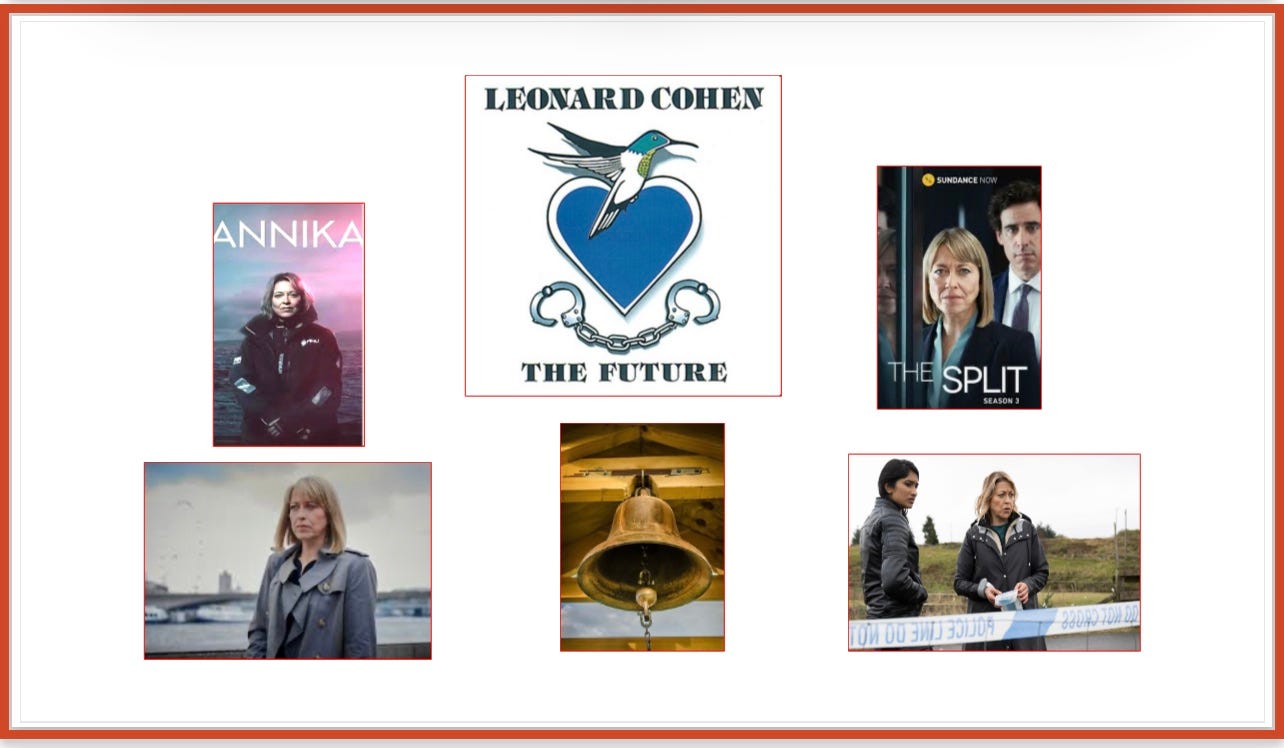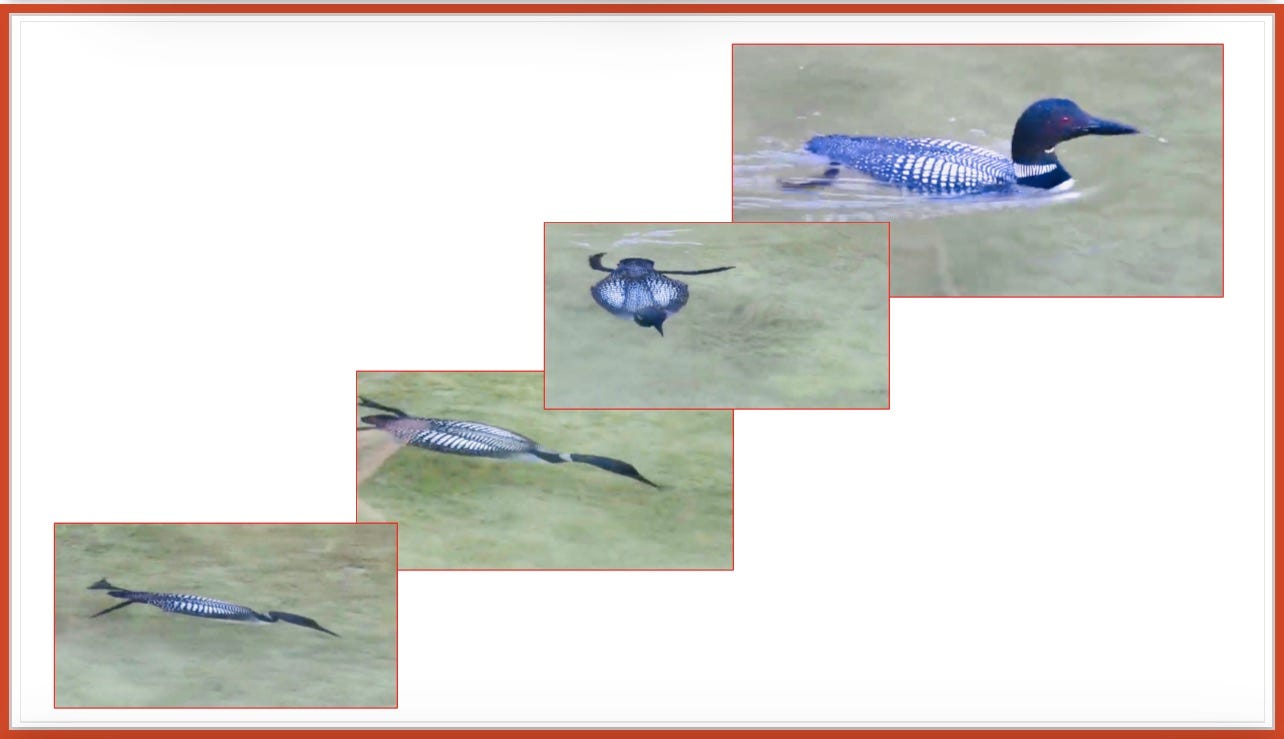Greetings, with wishes for a happy and safe Thanksgiving.
Neither this seasonal holiday nor news of the day is the stuff of dated late-night comedy riff, nor should they be. But list form is handy for the wide variety of things calling for newShrink gratitude this week.
Logistical note to readers: Several upcoming editions will likely be in such abbreviated, postcard or mainly headline forms. And frequency may not always be weekly between now and the end of January. At that time there will be a bit of a reset — no newShrink 2.0, but a refresher-reboot to gear up for what’s sure to be a wild ride of an election- and overall news-year.
Until then a priority focus of both practical and creative energies is on settling my late mother’s affairs and celebrating her life with those who knew and loved her. I was a much-wanted, enormously and widely loved first-born, who turned out to be an “only.” So just as this is a time of shared memories and loss, it is more one of gratitude — to her/them, and to others on her behalf as well.
Along with the week’s holiday, that is in part rationale for today’s Top-10 theme.
🦃
First, news: A look at several headlines in a category that’s rather a sign of the times…
better than nothing… have to be thankful; could be so much worse
(These from The New York Times):
#1. Senate Sends Biden Stopgap Funding Bill, Averting a Government Shutdown
#2. G.O.P. Ethics Chair Moves to Expel George Santos From Congress
#3. Biden-Xi Talks Lead to Little but a Promise to Keep Talking
(And from The Washington Post, in my own pick of the week’s pack it seems the originalists have newly discovered: Ethics — SHEZZAM?!?)
#4. Supreme Court, under pressure, issues ethics code specific to justices
(Well, only sort of…)
Supreme Court justices stung by controversies over the court’s ethics pledged Monday to follow a broad code of conduct promoting “integrity and impartiality,” but without a way to enforce its standards against those who fall short…
Levity aside, and lest we overlook just how much worse it can be and is…
🦃
Still from recent weeks’ news, about that title-tease…
surprise!
(From The Washington Post)
#5. A David Brooks column, with a lot of points I like!
The piece’s title wasn’t one of them, as is often my take on Brooks’ recent literary stances as self-appointed-expert-on-being-human. So I omit it here to focus on two of his themes I find powerful from both clinical and soul/psychological perspectives:
Here Brooks describes in a courageously open, self-disclosing way his personal process of wrestling with his own shadow aspects. The Jungian understanding of our interior psychodynamics explains further that our unconscious shadow is directly opposite and related to the excesses of our strongest, most highly developed — considered most “positive” — functions. Most simply, shadow is the inevitable flip-side when an adult life record has been one of always “playing to our strengths.” We then don’t know, or know how to access or make the most of, all else that has been relegated to “back burners.” Brooks is making the rare effort to rise to the challenge to individuate. Whatever our respective strongest tendencies and patterns, that inevitably means what Jung called going against our own grain: Intentionally learning sometimes to do what comes least automatically and reflexively — and what’s least comfortable. That looks and feels different, depending on what our most dominant, go-to patterns are.
(Brooks) “I absorbed my share of the normal blows that any adult suffers — broken relationships, personal failures, the vulnerability that comes with getting older. The ensuing sense of my own frailty was good for me, introducing me to deeper, repressed parts of myself. I learned that living in a detached way is a withdrawal from life, an estrangement not just from other people but also from yourself.
I’m not an exceptional person, but I am a grower. I do have the ability to look at my shortcomings and then try to prod myself into becoming a more fully developed person.
I have learned something profound along the way. Being openhearted is a prerequisite for being a full, kind and wise human being…”
Second, I find Brooks eloquent on a topic I have been thinking about a lot of late and discussing across some generational lines: The emphasis on, and importance of, experiencing and expressing genuine curiosity about one another as a fundamental necessity in human relationship and connection. From our most intimate ties to fleeting public interaction, in simplest terms this means asking sincere questions of one another. I share Brooks’ astonishment, even dismay, at how completely absent this is, often even in our most personal relationships and the interactions that younger generations see, emulate… and/or model.
(Brooks) “I see… clumsiness I encounter too frequently. I’ll be leaving a party or some gathering and I’ll realize: That whole time, nobody asked me a single question. I estimate that only 30 percent of the people in the world are good question askers. The rest are nice people, but they just don’t ask. I think it’s because they haven’t been taught to and so don’t display basic curiosity about others… [I would add that core temperament and personality patterns also are at play here; getting at working-against-our-own-type requires self-awareness work in addition to learned social and other skills.]
… “I’ve noticed along the way that some people are much better at seeing people than others are. In any collection of humans, there are diminishers and there are illuminators. Diminishers are so into themselves, they make others feel insignificant. They stereotype and label. If they learn one thing about you, they proceed to make a series of assumptions about who you must be.
Illuminators, on the other hand, have a persistent curiosity about other people. They have been trained or have trained themselves in the craft of understanding others. They know how to ask the right questions at the right times — so that they can see things, at least a bit, from another’s point of view. They shine the brightness of their care on people and make them feel bigger, respected, lit up.
Illuminators are a joy to be around. A biographer of the novelist E.M. Forster wrote, [emphasis here is newShrink’s]
‘To speak with him was to be seduced by an inverse charisma, a sense of being listened to with such intensity that you had to be your most honest, sharpest, and best self.’
Imagine how good it would be to offer people that kind of hospitality…”
🦃
Now shifting focus to the more seasonal theme, photos at top center:
#6. Welcome arrival, at last: Burning-bush shrubs aflame!
A favorite early-seasonal marker, burning-bush’s signature gorgeous colour had been absent through an unusually hot fall. Its finally showing up last week was later than any year in recent memory. (OK, only about three weeks overdue… but it began to spur reminders of the 40 years it took for the Biblical one to show up for Moses!)
Aptly enough, the Friday Wordle solve was: Tardy.
Lame jokes aside: Euonymus alatus, known variously as winged spindle, winged euonymus, or burning-bush, is a species of flowering plant in the family Celastraceae, native to central and northern China, Japan, and Korea. Once established it requires little to no care or attention to grow tall and full, with spectacular fall color, in the N.C. Piedmont and many other American growing zones as well.
🦃
Next, newShrink’s ongoing focus on history has both public and personal dimensions.
#7. two historic settings, one reflective occasion.
(Photo at bottom center in the lede illustration above.)
First personally, previous editions have described my late mother’s deep roots and lifelong passion for her native Charlotte and its past 95 years during her lifetime. So I’m thankful that our January ‘24 celebration of her can be at two historic locations of both public and of personal significance to her. Some of the dates and details now pinned-down are being shared here and elsewhere:
Date and Time: Saturday, January 20. This is the weekend after the MLK holiday. (The holiday is early next year, and the desired Duke historic site is closed the first two weeks of each January for major refurbishing and maintenance. This was a very lucky-hit, for our desired time of day was literally the last-available January weekend time-slot there at any hour of the day or evening.)
Celebration (noon-2:30 pm): The Historic Duke Mansion, 400 Hermitage Road in Charlotte. (On the personal history side, for nearly 50 years until 2006, this was a regular nearby neighborhood walking-route for some combination of three generations of my family — parents, a grandparent from each side, me for a time in earliest-apartment adulthood. At one point my mom got lots of comment from her fellow poll-workers when five of us, decades apart in age, living in four separate households, voted in the same nearby precinct on Election Day!
The nonprofit Mansion’s history is to me a public treasure as well. From its website:
Built in 1915 and tripled by its most famous owner James Buchanan Duke, The Duke Mansion has been home and host to leaders of the 20th century. Duke’s most lasting legacies, including Duke University, Duke Energy and the Duke Endowment, took shape at the home. Listed on the National Register of Historic Places, The Mansion is operated as a nonprofit with all proceeds being used to preserve and protect this community treasure.
It’s one I like supporting for its thoroughly researched and maintained, well-funded and community-supported preservations of state and local history. Charlotte’s energetic push for business, economic and cultural growth — into the “world-class-city” it at one point stated as its worthwhile goal — has far exceeded mere Chamber of Commerce enthusiasm or boosterism. In too many instances, that progress has been at the expense of timely salvaging, preservation, creative re-imagining and incorporation of the city’s rich historic core with the new. All are things that can so animate, en-soul, such a thriving, maturing city of pre-American Revolution colonial origins.
(following a 2:30 p.m. sheriff-escorted drive)
3 p.m. Dedication at Elmwood/Pinewood Cemetery. (700 West 6th Street in Charlotte.) Here again, 130 years of personal-family and public history mesh at this 150-year-old combination of two, once-segregated, burial grounds.
While Elmwood [established in 1853 after Settler’s Cemetery in 4th Ward was at capacity and closed to further burials] and Pinewood [established in 1873 to serve Black families] cemeteries are operated as and appear to be one, they were separated by a fence and had two distinct entrances until 1969. That was when Fred Alexander, Charlotte's first Black city council member since the 19th century, successfully led a movement to desegregate the cemeteries.
I well remember my mother’s vocal advocacy for removing the fence, desegregating and standardizing quality and maintenance across the entire cemetery. All of these cemeteries’ long, rich history, particularly in contexts of race relations and legacies of slavery and prominent enslavers, merit deeper dives in a separate edition in ‘24.
🦃
Looking toward closing here with lighter, more fictional and musical fare recalled last edition’s nod to vast range and quality of streamable new programs and movies. These are a saving grace for these too-early and long fall nights. Some of you commented on my new-found passion for the acting chops and wide range of a British actress I am finding riveting, Nicola Walker. (It’s under “Sunrise, Sunset”section toward the end of last edition’s Holding the Tension (11.5.23).
The revisit began a sequence that’s become a thanks-category that’s kept on giving.
# 8. “ring the bell that still can ring…”
In case you haven’t seen the drama series Annika, it’s set in those misty-water locales off the coast of Scotland, Isle of Man and other Inner Hebrides. In the title role Walker plays a complicated Marine Homicide DI, who makes quirky rather newShrink-y asides to us viewers. She taps obscure characters, quotes and themes from mythologies, literature, drama and poetry as somehow relevant to understanding the case at hand.
Thanks here to reader-friend and veteran journalist Lew Powell, who clearly knows his Annika. Lew’s signature-clever Sunday-morning comment first made me laugh. That dislodged from memory files the character’s absurdly many riffs in one episode on Sir Walter Scott’s work. When writing it had annoyingly eluded me.) Both seasons of Annika on PBS Masterpiece are streamable with Passport, also in Britbox through Amazon Prime and other sources.
Soon after, a close friend and reader revealed she also appreciates Walker — then recommended her in a starring role, look, feel and even program genre that could hardly be more different from her previous work. For me the plug was spot-on for the three-season, limited BBC family-in-family-law-firms legal drama, The Split. It has particular relevance from multiple depth-psychological perspectives, and important clinical issues as well.
That psyche-savvy tip was thanks to Pam Kelley, whose career-long, award-winning excellence — interestingly here — is as accomplished veteran journalist and non-fiction book author, not psychologist or therapist of any sort.
First a couple of caveats. Split is not the light-dishy fare or deliciously overdone soapy melodrama it may sound; it’s probably not what you’d call fun for the holidays, or about any other season. Those in deepest throes of unexpected or unwanted divorce, in intense denial about or active resistance to one, might best save it for viewing at a different time in key relationships.
That said, I found The Split excruciatingly good, the strength of the acting with so many superbly written main characters amazing. From soul/psychological standpoint, over three complex seasons characters demonstrate by living-out onscreen the core psychological challenges of adulthood: The life-loss/death-new life cycles of initiatory crises or thresholds. Each season’s featured legal cases and characters complement this process and deftly address such timely concerns as domestic abuse and end-of life directives
Unlike with much current fiction and drama, these characters all develop. They grow, struggle, screw up and succeed and backslide and confuse themselves, all beyond whatever was assumed. My favorites among them shifted, with one of my final pairs by the end of the series a big departure from my sense of them in season 1. (And OK, the nostalgic vintage VW camper involved may have influenced that!)
Often presented along metaphoric bridge with backdrop of the London Eye ferris wheel, the program’s recurring theme is each character’s cycles of life-loss-new life with their precipice-like decision points. Even in the series final episode, which I found both lingering and pitch-perfect, we have one of these elegantly drawn pivotal moments that personify the proverbial admonition to “be careful what we pray for ( for will we be brave and strong enough to accept it?”)
I was still pondering the series, vaguely wanting some internal musical gavel finale. It came with a spontaneous phone call from a reader and dear lifelong friend (who’s one of my mother’s chosen other-daughters.)
Thanks here are to Susan Lander Fowler, whose call spurred my recall of the Leonard Cohen lyric from the song Anthem: “ring the bells that still can ring/forget your perfect offering/there is a crack in everything/that’s how the light gets in.” She’ll probably scold me for writing her praises, but I should note that Susan was en route between necessary errands and appointments — in addition to growing demands of her developing musical labor-of-love. This holiday season she is leading and providing three of her community’s churches with handbell choir selections, a solo plus her connecting liturgical music on organ. (This is a creative new chapter that follows her long successful career as a business owner, superb friend, equestrian… and most of all mom to beloved Chris, excellent lawyer/spouse/dad and long one of my favorite humans. He could have been my godson, had any of us been Episcopalian or Catholic!)
The Cohen song is linked here, if it hasn’t timed-out on Spotify.
🦃
I’ll leave you now on two final notes, without which it wouldn’t be Thanksgiving…
#9. perennial joys…
It’s time again — my 5th — to run with 9,999 others on Thanksgiving morning at SouthPark in Charlotte! This year I am dropping back from 8k to preferred 5k course, where with more runners there’s more company, competition and fun. (I’ve plenty of endurance, am not fast. Yet on the longer course there are so few runners in my age and gender class that I “won” last year, the closest-second place runner 30 minutes behind!) At my rate, by mile 5 it’s downright lonely and boring out there.
The Trot benefits Charlotte-Mecklenburg Explorers Holiday Toy Drive, Samaritan’s Feet, Project Outpour and Second Harvest among others.
🦃
#10. …and forever ones
Another welcome late-arrival this fall season: First sighting Monday morning of the first solo, likely male, loon for cool weather season on the cove. (Last year’s was at the end of September.) He hovered at surface in view as though long enough to be sure I saw him. Then he took one of those signature-loony, seemingly endless deep dives before surfacing many yards away. No others have appeared yet, and Thursday just one pair of them appeared in the same place. I’m imagining he came to stake out the best winter real estate, then returned with partner for final OK.
And, that is all I have! Talk to you soon.
🦋💙 tish
… it is important that awake people be awake,
or a breaking line may discourage them back to sleep;
the signals we give — yes or no, or maybe —
should be clear: the darkness around us is deep.
— William Stafford, “A Ritual to Read to Each Other”








